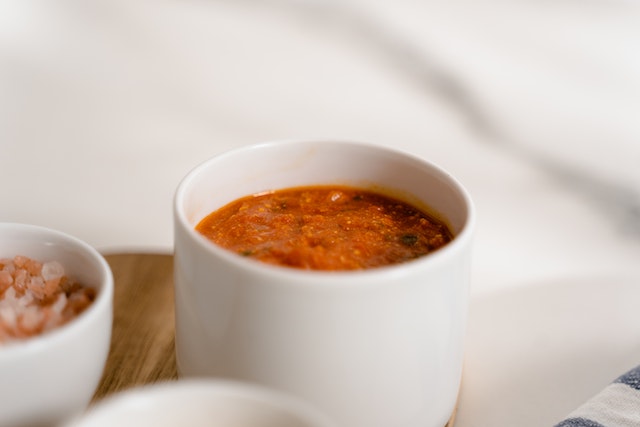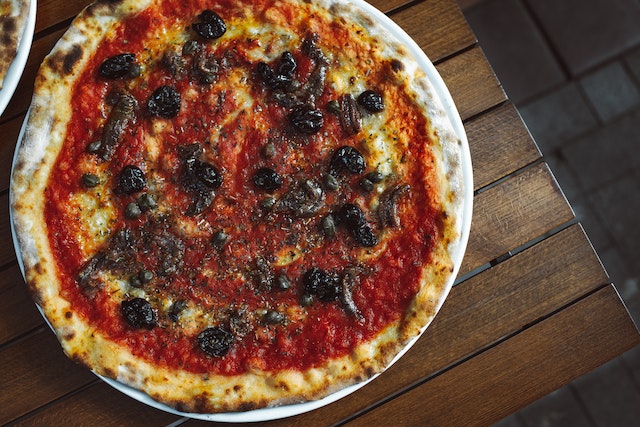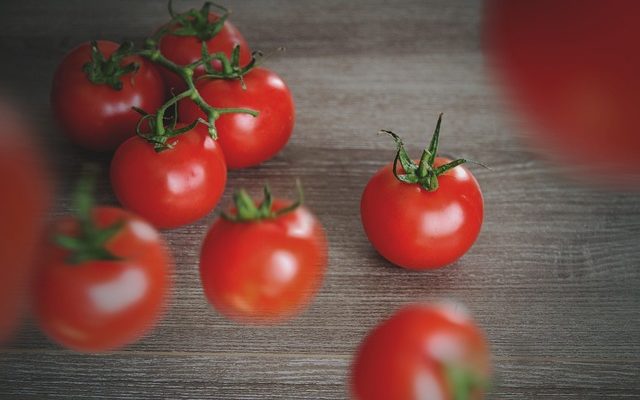Have you ever been faced with the dilemma of choosing between tomato sauce vs pizza sauce as a topping for your next pizza? The two sauces may seem quite similar, but there is actually an important difference between them. In this blog post, we’ll take a look at the similarities and differences between these two sauces to help you make an informed decision about which one is best for your needs. After reading this post, you’ll be able to confidently choose either tomato sauce or pizza sauce as the opt-in topping when ordering your favorite dish!
Table of Contents
About Tomato Sauce
Tomato sauce is a versatile condiment that can be used to enhance the flavor of a variety of dishes. It is made from tomatoes, garlic, herbs and spices, and is usually seasoned with salt and pepper. Tomato sauce can be used to top pizzas and pastas, or as a base for soups and sauces. It can also be used as an ingredient in recipes such as lasagna or chili.
There are many different types of tomato sauce available today. Marinara sauce is made with tomatoes, onions, garlic, basil, oregano, thyme and wine; while arrabbiata sauce contains tomatoes, chili flakes and garlic. Tomato sauces are also available in milder varieties such as vodka sauce – which has vodka cooked with cream and tomato puree – or even sweet sauces such as honey-roasted tomato sauce.
Tomatoes are an excellent source of lycopene – an antioxidant found in red fruits and vegetables that helps protect against heart disease – so adding tomato sauce to your diet may help improve your cardiovascular health. Additionally, tomatoes contain other beneficial nutrients such as potassium, vitamin A and vitamin C.
When shopping for tomato sauces make sure to read the label carefully; some versions contain added sugar or sodium – both of which should be avoided in order to maintain good health. Look for brands with ingredients you recognize like extra-virgin olive oil or fresh herbs instead of those containing preservatives or artificial ingredients. Homemade tomato sauces are an easy way to get all the benefits of lycopene without any added sugar or sodium!

How Is Tomato Sauce Made?
Tomato sauce is a classic condiment used to give dishes an extra zing of flavor. It’s made from one of the most popular vegetables in the world and can be used in a variety of recipes ranging from Italian favorites like pizza and pasta to American classics like tacos and chili. To make tomato sauce, you’ll need the following ingredients:
– Fresh tomatoes (or canned crushed tomatoes): If using fresh tomatoes, they should be ripe and firm enough to withstand boiling. A good ratio is 3 pounds of fresh tomatoes for every 2 cups of tomato sauce needed.
– Olive oil: This adds flavor and helps prevent the sauce from sticking to your pot when cooking.
– Onions: Use either yellow or white onions for the best flavor, diced finely so that they don’t overpower the other flavors.
– Garlic: Depending on your preference, use either fresh or powdered garlic for added depth of flavor, chopped finely if you’re using whole cloves.
– Herbs and spices: Basil, oregano, thyme, rosemary, parsley, bay leaf, nutmeg, black pepper—all these will help enhance the flavor profile of your homemade tomato sauce. Feel free to mix and match!
– Salt & sugar: The salt will bring out the sweetness in the tomatoes while balancing out acidity levels; a pinch of sugar helps with this too. Start with just a pinch until desired sweetness is achieved.
Instructions:
– If using fresh tomatoes, fill a large pot halfway with water and bring it to a boil over medium heat. Place whole tomatoes into boiling water and cook for 10 minutes or until skins peel off easily when pierced with a fork. Remove them from heat as soon as possible to avoid overcooking them; cool them down in an ice bath before removing skin. Once peeled, chop into chunks or mash up with a potato masher or immersion blender until desired consistency is achieved (some people like chunks while others prefer smoother sauces). Set aside any juices produced during cooking process; these are great for adding additional liquid when needed later on in recipe instructions below.
– Heat olive oil in another large pot over medium heat until lightly bubbling. Saute onions until golden brown; add garlic after onions have softened but not browned yet (about 5 minutes). Let cook together for another minute or two before adding herbs & spices next—basil, oregano, thyme and rosemary work well here!
– Pour mashed/chopped tomatoes along with their juices into pot containing onion mixture; stir everything together thoroughly before bringing it all up to low boil over medium heat (cover partially). Simmer uncovered for 20 minutes or until sauce has thickened slightly; stir occasionally so that nothing sticks/burns at bottom of pan! Add salt & sugar now if desired—start with small amounts first then adjust accordingly based on taste preferences after everything has cooked together properly (you could also wait until end).
– Once desired thickness has been achieved (should coat back of spoon nicely), turn off heat & let cool slightly before serving hot over favorite foods such as pasta dishes/pizza etc… Enjoy!
About Pizza Sauce
Pizza sauce is a savory sauce made from a blend of tomatoes and spices, which typically includes oregano, basil, and garlic. It is used to top pizzas before baking, giving them their classic flavor and texture. There are many varieties of pizza sauce available on the market today, ranging from traditional red sauces to more unique flavors like pesto or white sauces. Depending on the recipe or preference, some makers may choose to add additional ingredients such as onions, peppers, olives, anchovies and other herbs and seasonings to give their sauce its own individual flavor profile.
When choosing a pizza sauce for your favorite pie, there are many things you should keep in mind. First, look for one that has enough acidity to balance out the richness of melted cheese and other toppings. Secondly, you want something that will maintain its consistency when heated in the oven—a good quality pizza sauce won’t turn watery or overly thick while cooking. Lastly, be sure to consider the flavor profiles you’re trying to achieve with your dish—simple red sauces work great for traditional pies while more complex recipes may require different kinds of sauces and seasonings for a truly unique experience.
In addition to being used as topping for pizzas, pizza sauce can also be used in many other recipes such as lasagna or baked pasta dishes. To make sure it cooks correctly in these applications it can often be helpful to simmer it gently beforehand or add some extra tomato paste if needed. Another popular use is as dipping sauce; just mix together some olive oil with herbs like oregano and basil and serve alongside warm slices of bread or crunchy vegetables like carrots or celery sticks for an appetizing snack!
No matter how you wish to incorporate it into your culinary creations, pizza sauce is an essential ingredient for any kitchen pantry—it adds delicious flavor and is easy to customize based on personal preference! Try swapping out traditional red sauces for pesto-based ones when making pies at home or experiment with adding different combinations of seasonings depending on the occasion. With so many options available today it’s easy to find something that will satisfy even picky palates!

How Is Pizza Sauce Made?
The best pizza sauce recipe is one that combines a few simple ingredients to create the perfect balance of tartness, sweetness, and savoriness. Here is a list of what you will need:
– 2 tablespoons of olive oil
– 4 cloves of garlic, peeled and minced
– 1/2 cup of tomato sauce
– 1 teaspoon of dried oregano
– 1/4 teaspoon each of ground black pepper and onion powder
– 2 tablespoons of grated Parmesan cheese
– A pinch red pepper flakes (optional)
– Salt to taste
Start by heating the olive oil in a nonstick skillet over medium heat. Add the garlic and sauté until fragrant, about 30 seconds. Pour in the tomato sauce, oregano, pepper, onion powder, and Parmesan cheese; stir until evenly combined. Simmer for 5 minutes or until slightly thickened. Taste the sauce and adjust the seasoning with salt and red pepper flakes if desired. Remove from heat and set aside until ready to use on your favorite homemade pizza creations!
This versatile pizza sauce can also be used for lasagna or other Italian dishes. To make it even more flavorful try adding some minced fresh herbs like basil or parsley during the last minute of cooking. For an extra kick add some chopped Kalamata olives or capers. A splash of sherry vinegar or balsamic glaze is another great way to give this classic Italian tomato sauce a unique flavor profile!
What Are Some Recipes That Include Tomato Sauce?
A delicious list of recipes that incorporate tomato sauce can be a great way to add some extra flavor and pizzazz to your culinary creations. Whether you’re looking for the perfect Italian-inspired meal, a Mexican-themed dish, or just something easy and fun for a weeknight dinner, there’s sure to be something on this list that will suit your taste!
Starting off with some classic Italian favorites, you can make a batch of homemade spaghetti and meatballs with fresh tomato sauce. If you’d like to put your own spin on an old favorite, try making a lasagna bolognese with layers of ricotta cheese and ground beef mixed in with a robust tomato sauce.
For an easy weeknight meal, try out tacos made with slow cooker carnitas and homemade salsa verde. Top it off with some melted cheese and creamy avocado slices for an extra special touch. You can also serve up enchiladas filled with chicken, black beans, and bell peppers cooked in a smoky chipotle tomato sauce. A side of refried beans or Spanish rice would complete the meal nicely!
For those looking for something lighter yet still full of flavor, give grilled shrimp scampi over linguine pasta tossed in garlic-infused olive oil and tomatoes a try. Or for another seafood medley, whip up scallops served alongside sautéed peppers and onions in roasted tomato cream sauce—a real restaurant style hit!
With these recipes including tomato sauce as an ingredient, you won’t need to worry about worrying about finding something to cook again! From savory pastas to tacos to seafood dishes—there’s something here that is sure to become one of your go-to meals every week. Plus with the added bonus of fresh tomatoes providing natural nutrition along with their amazing flavor makes these recipes even more delicious!

Tomato Sauce Vs Pizza Sauce Comparison: Face To Face
Tomato sauce and pizza sauce are two sauces that are commonly confused with each other, yet are distinctly different. In terms of flavor and texture, both sauces have their own unique profiles.
Tomato sauce is a smooth, tangy condiment typically made from tomato puree, herbs and spices such as basil, oregano, garlic powder and onion powder. It’s also usually flavored with olive oil or butter for a rich flavor. Tomato sauce can be used in many dishes including on pasta, pizza, in casseroles and as an ingredient in soups and stews. It’s also great for dipping breads into or spreading onto sandwiches for added moisture.
Pizza sauce on the other hand is more robust than tomato sauce as it has more pronounced flavors like garlic, oregano, basil and sometimes even red pepper flakes. Unlike tomato sauce which tends to be smooth in texture, pizza sauce is chunky with small bits of tomatoes visible; this gives it a slightly thicker consistency which helps keep the topping ingredients on the pizza while baking. As its name suggests, pizza sauce is most often used on pizzas but can also be spooned over cooked pasta dishes or spread onto focaccia bread before baking for a yummy addition to any meal.
When it comes to nutrition facts, tomato sauce tends to contain fewer calories than pizza sauce due to its thinner consistency; however both contain no saturated fat or cholesterol making them healthier options than some of the higher-fat condiments available at grocery stores. Tomato sauces typically have slightly more sugar per serving than pizza sauces due to added sweeteners like honey or molasses but both tend to provide some health benefits from naturally occurring vitamins and minerals such as vitamin C, vitamin A and iron found in tomatoes.
Overall the difference between tomato sauce and pizza sauce comes down to texture and flavoring; tomato sauces tend to be smoother in texture with more subtle flavors while pizza sauces are usually chunkier with bolder seasoning profiles which make them perfect for layering over pizzas. However either one can be substituted depending on what kind of dish you’re preparing so experiment until you find your favorite!
>>> You might also like:
Chicken Breast Vs Chicken Tenderloin
Best Electric Smokers Consumer Reports
FAQs About Tomato Sauce Vs Pizza Sauce
What Is The Difference Between Tomato Sauce And Pizza Sauce?
Tomato sauce and pizza sauce are both variations of tomato-based sauces, but they have distinct differences. Tomato sauce is a thick, smooth puree that can be used as a base for many dishes such as pasta or lasagna. It typically consists of tomatoes, onions, garlic, sugar, herbs and spices cooked together to create a flavorful red sauce that can be used in a variety of dishes. Pizza sauce on the other hand is thinner than traditional tomato sauce and has more herbs and spices added to it along with seasonings such as oregano and basil. It is designed to be spread on a pizza crust before any other toppings are added for an extra layer of flavor.
What Are The Benefits Of Using Tomato Sauce?
Tomato sauce adds flavor to dishes without adding too much sodium or fat. It also provides many vitamins and minerals such as vitamin A, vitamin C, lycopene, iron, potassium, magnesium and folate just to name a few. Tomatoes are also known for their anti-inflammatory properties which can help reduce inflammation in people with chronic health issues like arthritis or heart disease. Additionally, due to its high antioxidant content, it may also help protect cells from damage caused by free radicals which can lead to disease.
What Type Of Dish Should Use Pizza Sauce Versus Tomato Sauce?
Pizza sauces tend to be spicier than regular tomato sauces because they usually contain oregano and basil which give them an extra kick of flavor that complements the other toppings typically found on a pizza rather than overpowering them like regular tomato sauces would do. Therefore pizza should almost always be made with pizza sauce instead of regular tomato sauce while dishes like lasagna or spaghetti should use traditional tomato sauces instead because they need something thicker that will adhere better to noodles or fillings while still providing enough moisture so everything cooks evenly.
>>> See more: pizza sauce recipe | homemade pizza sauce recipe
Conclusion
While both tomato sauce vs pizza sauce are delicious, they serve different purposes. Tomato sauce is a more versatile condiment that can be used on pasta, chicken, or vegetables, while pizza sauce is specifically for pizzas. When choosing between the two, it all comes down to personal preference and what you’ll be using it for. If you’re looking for a generalpurpose tomato-based sauce, go with tomato sauce. If you want something specifically for dipping your pizza in, go with pizza sauce.
The Cafe Toscana Restaurant blog is a great place to learn about the latest news and events happening at the restaurant.

